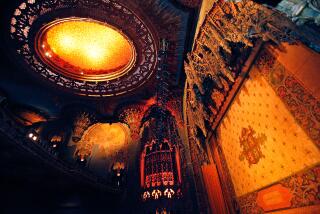Shanghai’s Peace Hotel back in the swing of things
- Share via
Reporting from Shanghai — Charlie Chaplin stayed there. Noel Coward wrote “Private Lives” from the comfort of one of the suites. The all-night costume balls, boozy dinners and back-room business deals are things of legend in this city once known as the Paris of the Orient. And then suddenly, with the outbreak of war, the party was over at the Peace Hotel.
There is no other landmark in Shanghai so closely associated with the city’s storied history. The hotel’s heyday lasted a scant eight years, from its opening as the Cathay Hotel in 1929 to the outbreak of fighting between Japan and China in 1937. The hotel, along with much of Shanghai, fell into disrepair.
Today, it has returned to its boom-time roots. After three years, $73 million worth of refurbishment and more than a few delays, a meticulously restored and updated Peace Hotel reopened last month, hoping to offer visitors the modern equivalent of 1920s luxury. (At modern luxury prices: rooms start around $350 a night.)
And, as the hotel presents its shining old face to the public, the realities of modern Shanghai have rarely been so clearly juxtaposed with a picture of the city’s freewheeling past.
“Shanghai is one of the most difficult cities in the world to interpret,” said Shanghai historian Peter Hibbard, who consulted on the refurbishment of the hotel. “You never know what’s old or what’s new.”
The hotel itself, by Shanghai standards, is pretty clearly old. It was opened by Victor Sassoon, a real estate tycoon whose family came to Shanghai on the wave of the opium trade. His hotel was designed in a kind of Gothic Art Deco style, trimmed with black iron flourishes.
“It was a kind of austere Deco,” said Ian Carr, a principal at Hirsch Bedner Associates, the design company selected to lead the restoration project.
In 1937, a bomb exploded in front of the building’s Nanjing Road entrance. Japanese troops eventually made the Cathay one of several headquarters in their occupation of the city. In 1956, it was reopened as the Peace Hotel and catered to a clientele of visitors from the Soviet Union and other communist bloc allies.
Remodeling started up again in the 1980s, blurring the line between what was original and what was new. Hotel rooms were renovated and made smaller. The first floor was taken over by small shops. A dingy roof was erected, hiding a domed glass ceiling. It became dark and claustrophobic.
This was the state of things when Carr and HBA first arrived. There was some difficulty in establishing what, exactly, the hotel had looked like in 1929. The group ran ads in the Shanghai Daily looking for mementos or photos that people may have collected over the years. They tracked down the remaining Sassoon family in the Bahamas and sifted through piles of old party announcements.
Carr also faced the problem of an unmovable tenant.
Although the small shops on the first floor had been cleared out, state-owned China Telecom held fast to a set of second-floor offices. Renovations had to be done around them. All that separates the Art Deco lobby from the office space is a plate of opaque yellow glass, part of the famed domed ceiling.
“We were trying to negotiate 6 or 12 inches from their space so we could shield what was going on in their offices from our visitors,” Carr said with a sigh. “If they lean their wet umbrellas on it, you can see it.”
Hilgers is a special correspondent.
More to Read
Sign up for The Wild
We’ll help you find the best places to hike, bike and run, as well as the perfect silent spots for meditation and yoga.
You may occasionally receive promotional content from the Los Angeles Times.






